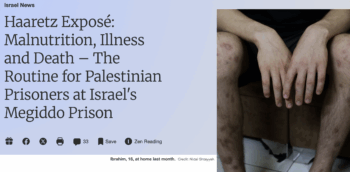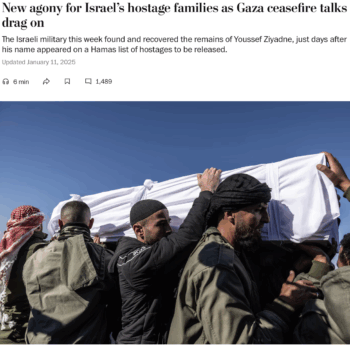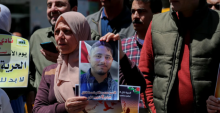

Ahmed Saeed Tazaz’a, 20, died in Israel’s Megiddo prison in August 2025. He was never charged or tried—and his death was never covered by US corporate media.
The different treatment accorded to the plights of Palestinian and Israeli prisoners by US corporate media illustrates a persistent double standard that treats some people as more human than others.
Take 20-year-old Palestinian prisoner Ahmed Saeed Tazaz’a, who died in Israel’s Megiddo Prison after nearly three months of illegal detention, according to the Commission of Detainees and Ex-Detainees Affairs (CDA), an agency of the Palestinian Authority (8/3/25).
Tazaz’a, who was from Jenin in the northern occupied West Bank, was imprisoned on May 6 of this year without a charge or a trial. He was held under Israel’s policy of “administrative detention,” which locks up Palestinians indefinitely “on the grounds that he or she plans to break the law in the future,” according to the Israeli human rights group B’Tselem. Tazaz’a did not suffer from prior health problems before his arrest, according to his family (WAFA, 8/7/25).
There are currently some 3,613 Palestinians under administrative detention in Israeli prisons, according to the July 2025 CDA report, and more than 10,000 Palestinians in Israeli custody (not including those held in military camps) in total. Even Israel’s own military intelligence only identifies a quarter of its detainees from Gaza as “fighters,” while human rights groups and Israeli soldiers have reported even fewer—roughly 15%—as Hamas members (Guardian, 9/4/25).
The CDA reports that Tazaz’a was the 76th identified Palestinian to die in Israeli custody since October 7, 2023.
And yet, while the fates of Israelis held captive by Hamas regularly make front-page news, US corporate media have not reported on Tazaz’a’s death—much less investigated it. Among the few news outlets to report his death were the Palestine News & Information Agency (WAFA, 8/7/25), Yemen News Agency (8/3/25), Haaretz (8/6/25), DropSite (8/3/25), Middle East Monitor (8/4/25) and Middle East Eye (8/19/25).
“There is no value for life”
Since January 1, 2025, the CDA and foreign media have recorded at least 13 deaths of Palestinians held captive by Israel:
- Musab Al-Ayadeh, age 20, at Ofer Prison (died on 8/25/25);
- Ahmed Saeed Tazaz’a, 20, at Megiddo Prison (reported 8/3/25);
- Sameer Mohammad Yousif al-Rifai, 53 (7/17/25);
- Mohyee al-Din Fahmi Najem, 60, at Naqab Prison (5/4/25);
- Walid Ahmad, 17, at Megiddo Prison (3/22/25);
- Rafaat Abu Fanouneh, 34, at Ramla Prison (2/26/25);
- Khaled Mahmoud Qassem Abdullah, 40, at Megiddo Prison (2/23/25);
- Ali Ashour Ali al-Batsh, 62, at Naqab Prison (2/21/25);
- Sayel Rajab Abu Nasr, 60 (1/21/25, revealed on 6/30/25);
- Mutaz Abu Znaid, at Gadot Prison (1/13/25);
- Musab Haniya, 35 (1/5/25, revealed on 2/24/25);
- Ibrahim Adnan Ashour, 25 (6/23/24, revealed on 1/29/25);
- Mohammad Sharif al-Asali, 35 (5/17/24, revealed on 1/29/25).
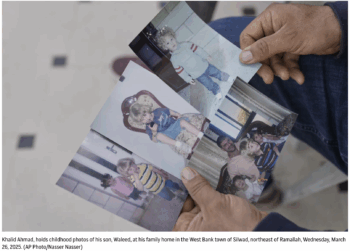
The Associated Press (4/1/25) interviewed the family of Walid Ahmad, 17, reportedly the youngest Palestinian prisoner to die in an Israeli prison since October 7.
Of these 13 deaths, only one—that of 17-year-old Brazilian-Palestinian Walid Ahmad—prompted any coverage in US corporate news outlets, according to a FAIR search of the US Newsstream Collection on ProQuest and supplemental Nexis and Google searches.
Ahmad died in Megiddo Prison on March 22, reportedly the youngest Palestinian to die in an Israeli prison since October 7. The Associated Press ran two original reports about Ahmad’s death (4/1/25, 4/6/25, plus a brief followup at the end of another piece—4/11/25) that a few other outlets republished, and CNN (4/6/25) ran one original report .
On April 1, the AP published a detailed report by Julia Frankel headlined “A Palestinian From the West Bank Is First Detainee Under 18 to Die in Israeli Prison, Officials Say.” The article reported that Ahmad “was held in an Israeli prison for six months without being charged [and] died after collapsing in unclear circumstances.” It noted that his father said Ahmad “was a lively teen who enjoyed playing soccer before he was taken from his home in the occupied West Bank during a predawn arrest raid”; his family said he was arrested “for allegedly throwing stones at soldiers.” (Stone-throwing is an all-too-common charge levied against Palestinian children by Israeli forces, according to a July 2024 Save the Children report.)
The piece offered the context that “rights groups have documented widespread abuse in Israeli detention facilities,” that Megiddo prison “has previously been accused of abusing Palestinian inmates,” and that “conditions in Israeli prisons have worsened since the start of the war,” in all three cases linking to its own previous reporting. In its conclusion, the article reported that “an autopsy is needed to determine the cause of death. Israel has agreed to perform one but a date has not been set.”
AP correspondent Sam Mednick followed up on April 6 with a shorter article on the outcome of that autopsy, headlined “Palestinian Teenager Who Died in Israeli Prison Showed Signs of Starvation, Medical Report Says.” Mednick cited a report from Dr. Daniel Solomon—a gastrointestinal surgeon who was “granted permission to observe the autopsy by an Israeli civil court”—which confirmed that Ahmad “likely suffered from inflammation of the large intestine, a condition known as colitis that can cause frequent diarrhea and can in some cases contribute to death.” Solomon’s report “did not conclude a cause of death, but said Ahmad was in a state of extreme weight loss and muscle-wasting.”
Mednick also quoted Dr. Lina Qasem Hassan, the head of the board for Physicians for Human Rights Israel, saying that Ahmad
suffered from starvation that led to severe malnutrition and in combination with untreated colitis that caused dehydration and electrolyte levels disturbances in his blood which can cause heart rate abnormalities and death.
“We will demand our son’s body for burial,” the piece quoted Walid’s father Khalid Ahmad as saying. “What is happening in Israeli prisons is a real tragedy, as there is no value for life.”
Palestinian prisoners: not newsworthy?
By all measures, the AP’s stories were well-sourced, humanizing and put into appropriate context—yet few other US outlets picked them up. The Boston Globe (4/1/25) ran the first piece on its website, as did PBS (4/1/25); the Atlanta Journal-Constitution (4/2/25) ran a two-paragraph version in a news roundup. The Los Angeles Times didn’t run the first piece, but it was the only US newspaper we found to publish a full-length version of the followup that we could find on either ProQuest or Nexis.
The Wall Street Journal (4/2/25, 4/7/25) ran brief, digest-style versions of the two stories. The Washington Post (4/7/25) ran a similarly short version of only the second story, while the New York Times seemed to have not picked up either at all.
CNN (4/6/25) is the only other US corporate news outlet to publish original reporting on Ahmad’s cause of death. The network obtained a copy of the autopsy report, which
described signs of severe weight and muscle loss, including loss of muscle mass at the temples, a sunken appearance at the abdomen and “almost absent muscle mass or subcutaneous fat on trunk and extremities.”
“Autopsy findings suggest that Walid suffered from extreme, likely prolonged malnutrition as observed by his deeply cachectic state and complaints of inadequate food intake since at least December 2024,” it said. “It needs to be noted that malnutrition increases the risk of infectious complications including severe sepsis,” it added.
International and independent accounts
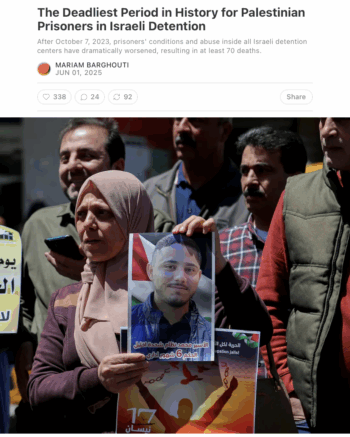
Independent outlet Drop Site (6/1/25) published an in-depth look at the abuses of Palestinian prisoners rampant across Israeli prisons.
It’s not particularly difficult for US journalists to find details about these deaths—including the unlawful conditions and/or abuse causing or coinciding with them—as the details are extensively documented by their overseas counterparts (mainly in the Middle East). Some independent US media, such as DropSite (6/1/25) and Infinite Jaz (8/10/25), have also reported in recent months on deaths within Israeli prisons beyond that of Ahmad.
Among the disturbing allegations found in international and independent press accounts, and human rights reports:
- WAFA (5/4/25), Arab News (5/4/25) and Middle East Eye (5/4/25) reported that Najem “suffered from chronic illnesses and was denied proper medical care during his incarceration,” which were accusations made by the CDA and the Palestinian Prisoners’ Society. Qods International Agency (5/5/25) reported similar abuses.
- Yemen News Agency (5/8/25) reported that Fanouneh, al-Batsh, Haniya, al-Asali and Ashour “were civilians with no affiliation with resistance factions, and died as a result of torture in Israeli slaughterhouses and deliberate medical neglect.”
- Yemen News Agency (7/30/25) also reported Nasr “died under harsh and degrading detention conditions,” citing a Hamas statement.
- The CDA (1/14/25), citing a conversation with a “recently released detainee,” reported Znaid “was suffering from an advanced stage of scabies, during which occupation authorities deprived him of life-saving medical care, leading to his killing.” Citing a Hamas statement, Iran’s Press TV (1/13/25) reported Znaid was killed due to ‘“torture and brutal measures.”’
- WAFA (7/17/25) reported al-Rifai “suffered from heart problems before his detention and required intensive medical follow-up,” according to medical reports provided by his family.
- London-based Reuters (2/17/25) quoted Palestinian medic and ambulance worker Tarek Rabie Safi on Mussab Haniya: “This young man was strong, but due to lack of food, lack of drinks and frequent torture, he was martyred before our eyes.”
And these deaths are only the latest chapter in a long, well-documented history of abuse in Israeli prisons. From Israel’s illegal occupation of the West Bank and Gaza Strip in 1967 to 2006 (the most recent data available), Israel had imprisoned more than 800,000 Palestinians (OHCHR, 6/9/23); an updated figure would likely be much higher. Of these prisoners, 314 have died in Israeli custody (CDA, 8/25/25).
Prison abuses continue, coverage doesn’t
In 2024, at least a few deaths of Palestinian prisoners were covered by US corporate media outlets, including those of Dr. Adnan Ahmad Albursh, chief of orthopedics at Al-Shifa hospital (New York Times, 5/3/24) and Iyad al-Rantisi, director of the Kamal Adwan Hospital in Beit Lahia (Washington Post, 7/1/24). The Journal notably published an article (more than 2,500 words) about how the deaths of Albursh and other imprisoned Palestinians “fuel allegations of abuse” (8/8/24).
The abuses within Israel’s Sde Teiman military detention center were also highlighted in US corporate media outlets, including the Post (6/5/24), Journal (7/30/24), Business Insider (5/11/24), and, most thoroughly, CNN (5/11/24) and the Times (6/6/24).
In 2025, meanwhile, the Post and Times sometimes placed details about Israeli prison conditions below Palestinian prisoners’ alleged ties to terrorism and/or terrorist acts (Washington Post, 1/25/25) (New York Times, 3/7/25).
In 2025, the Times also published an article (2/19/25) about Sde Teiman headlined “Israeli Military Prosecutor Charges Five Reservists With Abuse of Detainee.” It failed to name the detainee, writing that he “was identified only by his initials.”
The lack of US media attention in 2025 cannot be attributed to a lack of either abuses or available leads. In July, an exposé by Israeli newspaper Haaretz (7/6/25) showed Megiddo Prison to be one of the more brutal of Israeli prisons. The report revealed “medical neglect,” including the “rampant spread” of scabies and a “high probability of an outbreak of a contagious intestinal disease” leading to diarrhea and weight loss, which was also caused in part by reduced food rations. Routine violence at Megiddo Prison is also prevalent, including gas spray in the prisoners’ faces, baton beatings, kicking and the assault of inmates with fists or clubs.
Haaretz described the deaths of two Palestinian prisoners, one of whom suffered “broken ribs and a broken sternum” and was “severely beaten in the head before his death” and another of whom suffered from “broken ribs, a damaged spleen and severe inflammation in both of his lungs.” Such conditions had previously been documented repeatedly by the CDA (4/13/25, 4/13/25, 5/28/25) and Addameer (3/14/25, 5/12/25).
The Haaretz article expanded on the death of Ahmad, including that he “collapsed in the prison yard and died.” Haaretz included the doctor’s finding that Ahmad “had almost no fatty tissue left in his body, suffered from colon inflammation and was infected with scabies.”
Haaretz also reported that, when asked whether the autopsy “led to any action,” the Health Ministry “refused to provide details.” The article included input from a 16-year-old inmate, identified by Haaretz under the pseudonym “Ibrahim,” who said that after Ahmad’s death, “the violence decreased but didn’t stop.”
No corporate US news outlet has covered or followed up on Haaretz‘s report.
Front-page news: ‘Israeli hostages’
By comparison, the US corporate press has put far greater focus on Israeli prisoners held by Hamas—highlighting a long-documented double-standard.
On October 7, 2023, Hamas and other Palestinian militant groups abducted at least 252 people from Israel to the Gaza Strip—a little more than 2% of the reported current Palestinian prisoner total. About 20 were “members of Israeli Security Forces, many of whom have since been killed in captivity” (United Nations, 6/10/24). Since then, 148 Israeli prisoners have been returned alive to Israel, along with the remains of more than 50 others. As of July 31, 50 more Israelis remain held by Hamas, though the IDF believes 28 of these are dead (Times of Israel, 7/31/25).
Since January 1, 2025, we found that the remains of 21 Israelis captured on October 7, 2023, have been returned to or recovered by Israel (CNN, 9/15/25). Every one of these Israeli prisoners was mentioned in news coverage in US corporate newspapers in 2025, according to our ProQuest analysis. At least seven of these Israeli prisoners were mentioned or featured in front-page news stories in 2025:
- A photo captioned “Hamas with a coffin bearing the photo of Kfir Bibas, an Israeli infant who was taken hostage with his parents and brother” appeared on A1 of the February 21 New York Times print edition (2/21/25). The next day, a “news analysis” article (2/22/25) about the deaths of Shiri Bibas and her two young sons appeared on A1 of the print edition. The Bibas family was also mentioned on A1 of the February 23 Washington Post print edition (2/23/25).
- Gad and Judi Haggai were mentioned on A1 of the March 19 USA Today print edition (3/19/25).
- Yousef and Hamza Alziadana were featured on A1 of the January 12 Washington Post print edition (1/12/25).
To be clear, media should be reporting on Israeli captives—not just on their deaths, but when they are released as well, detailing their experiences.
It only serves the interests of the Israeli government, however, for US corporate media to foreground the plight of Israelis held by Hamas while failing to do so for Palestinians in Israeli captivity—especially when the latter are a part of what many nations, politicians, scholars, experts and others deem a “genocide.”
By Drew Favakeh

